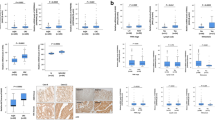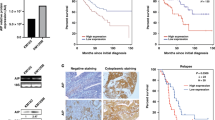Abstract
Colorectal cancer (CRC) is a complex disease with still unsatisfactory prognosis even in western societies, although substantial progress has been made in pre-screening programs, surgical techniques and targeted therapy options. Mediator of motility-1 (Memo-1) was previously recognized as an important effector of cell migration downstream of receptor tyrosine kinase signaling in breast cancer. This study identified Memo-1 as frequently overexpressed in CRC and established a close link between extracellular HER2 activation, AhR/ARNT transcriptional activity and Memo-1 expression. Dissection of the hMemo-1 gene promoter using reporter assays and chromatin IP techniques revealed recruitment of Aryl hydrocarbon receptor (AhR)/Aryl hydrocarbon receptor nuclear-translocator (ARNT) complex, which positively influenced Memo-1 expression in cancer cells. We found that Memo-1 depletion negatively influenced the cellular actin network and that its expression is required for HER2-mediated cell migration and invasion. Moreover, analyses of Memo-1 expression in primary CRC revealed correlation with clinical parameters that point to Memo-1 as a new prognostic factor of aggressive disease in CRC patients. Altogether, these observations demonstrate that Memo-1 is an important downstream regulator of HER2-driven CRC cell migration and invasion through connecting extracellular signals from membrane to the cytoskeletal actin network.
This is a preview of subscription content, access via your institution
Access options
Subscribe to this journal
Receive 50 print issues and online access
$259.00 per year
only $5.18 per issue
Buy this article
- Purchase on Springer Link
- Instant access to full article PDF
Prices may be subject to local taxes which are calculated during checkout







Similar content being viewed by others
References
Jemal A, Bray F, Center MM, Ferlay J, Ward W, Forman D . Global cancer statistics. CA Cancer J Clin 2011; 61: 69–90.
Ferlay J, Soerjomataram I, Dikshit R, Eser S, Mathers C, Rebelo M et al. Cancer incidence and mortality worldwide: sources, methods and major patterns in GLOBOCAN 2012. Int J Cancer 2015; 136: E359–E386.
Romiti A, Onesti CE, Roberto M, Barucca V, Tomao S, D'Antonio C et al. Continuous, low-dose capecitabine for patients with recurrent colorectal cancer. Med Oncol 2015; 32: 54.
Chaffer CL, Weinberg RA . A perspective on cancer cell metastasis. Science 2011; 331: 1559–1564.
Rodriguez OC, Schaefer AW, Mandato CA, Forscher P, Bement WM, Waterman-Storer CM . Conserved microtubule-actin interactions in cell movement and morphogenesis. Nat Cell Biol 2003; 5: 599–609.
Iwatsuki M, Mimori K, Yokobori T, Ishi H, Beppu T, Nakamori S et al. Epithelial-mesenchymal transition in cancer development and its clinical significance. Cancer Sci 2010; 101: 293–299.
Roskoski R Jr . The ErbB/HER family of protein-tyrosine kinases and cancer. Pharmacol Res 2014; 79: 34–74.
Ross JS, McKenna BJ . The HER-2/neu oncogene in tumors of the gastrointestinal tract. Cancer Invest 2001; 19: 554–568.
Ingold Heppner B, Behrens HM, Balschun K, Haag J, Krüger S, Becker T et al. HER2/neu testing in primary colorectal carcinoma. Br J Cancer 2014; 111 (10): 1977–1984.
Lemmon MA, Schlessinger J, Ferguson KM . The EGFR family: not so prototypical receptor tyrosine kinases. Cold Spring Harb Perspect Biol 2014; 6: a020768.
Atlas E, Cardillo M, Mehmi I, Zahedkargaran H, Tang C, Lupu R . Heregulin is sufficient for the promotion of tumorigenicity and metastasis of breast cancer cells in vivo. Mol Cancer Res 2003; 1: 165–175.
Momeny M, Saunus JM, Marturana F, McCart Reed AE, Black D, Sala G et al. Heregulin-HER3-HER2 signaling promotes matrix metalloproteinase-dependent blood-brain-barrier transendothelial migration of human breast cancer cell lines. Oncotarget 2015; 6: 3932–3946.
Marone R, Hess D, Dankort D, Muller WJ, Hynes NE, Badache A . Memo mediates ErbB2-driven cell motility. Nat Cell Biol 2004; 6: 515–522.
Zaoui K, Honore S, Isnardon D, Braguer D, Badache A . Memo-RhoA-mDia1 signaling controls microtubules, the actin network, and adhesion site formation in migrating cells. J Cell Biol 2008; 183: 401–408.
Sorokin AV, Chen J . MEMO1, a new IRS1-interacting protein, induces epithelial mesenchymal transition in mammary epithelial cells. Oncogene 2013; 32: 3130–3138.
MacDonald G, Nalvarte I, Smirnova T, Vecchi M, Aceto N, Dolemeyer A et al. Memo is a copper-dependent redox protein with an essential role in migration and metastasis. Sci Signal 2014; 7: ra56.
Maletzki C, Stier S, Gruenert U, Gock M, Ostwald C, Prall F et al. Establishment, characterization and chemosensitivity of three mismatch repair deficient cell lines from sporadic and inherited colorectal carcinomas. PLoS One 2012; 7: e52485.
Stier S, Maletzki C, Klier U, Linnebacher M . Combinations of TLR ligands: a promising approach in cancer immunotherapy. Clin Dev Immunol 2013; 2013: 271246.
Baselga J, Swain SM . Novel anticancer targets: revisiting ERBB2 and discovering ERBB3. Nat Rev Cancer 2009; 9: 463–475.
Jiang K, Yang Z, Cheng L, Wang S, Ning K, Zhou L et al. Mediator of ERBB2-driven cell motility (MEMO) promotes extranuclear estrogen receptor signaling involving the growth factor receptors IGF1R and ERBB2. J Biol Chem 2013; 288: 24590–24599.
Hannafon BN, Sebastiani P, de las Morenas A, Lu J, Rosenberg CL . Expression of microRNA and their gene targets are dysregulated in preinvasive breast cancer. Breast Cancer Res 2011; 13: R24.
Zhao S, Ohara S, Kanno Y, Midorikawa Y, Nakayama M, Makimura M et al. HER2 overexpression-mediated inflammatory signaling enhances mammosphere formation through up-regulation of aryl hydrocarbon receptor transcription. Cancer Lett 2013; 330: 41–48.
Feng S, Cao Z, Wang X . Role of aryl hydrocarbon receptor in cancer. Biochim Biophys Acta 2013; 1836: 197–210.
Qiu C, Lienhard S, Hynes NE, Badache A, Leahy DJ . Memo is homologous to nonheme iron dioxygenases and binds an ErbB2-derived phosphopeptide in its vestigial active site. J Biol Chem 2008; 283: 2734–2740.
Opitz CA, Litzenburger UM, Sahm F, Ott M, Tritschler I, Trump S et al. An endogenous tumour-promoting ligand of the human aryl hydrocarbon receptor. Nature 2008; 478: 197–203.
Gramatzki D, Pantazis G, Schittenhelm J, Tabatabai G, Köhle C, Wick W et al. Aryl hydrocarbon receptor inhibition downregulates the TGF-beta/Smad pathway in human glioblastoma cells. Oncogene 2009; 28: 2593–2605.
Lai DW, Liu SH, Karlsson AI, Lee WJ, Wang KB, Chen YC et al. The novel Aryl hydrocarbon receptor inhibitor biseugenol inhibits gastric tumor growth and peritoneal dissemination. Oncotarget 2014; 5: 7788–7804.
Zegers MM, Friedl P . Rho GTPases in collective cell migration. Small GTPases 2014; 5: e28997.
Carvajal-Gonzalez JM, Mulero-Navarro S, Roman AC, Sauzeau V, Merino JM, Bustelo XR et al. The dioxin receptor regulates the constitutive expression of the vav3 proto-oncogene and modulates cell shape and adhesion. Mol Biol Cell 2009; 20: 1715–1727.
Takenawa T, Suetsugu S . The WASP-WAVE protein network: connecting the membrane to the cytoskeleton. Nat Rev Mol Cell Biol 2007; 8: 37–48.
Applewhite DA, Barzik M, Kojima S, Svitkina TM, Gertler FB, Borisy GG . Ena/VASP proteins have an anti-capping independent function in filopodia formation. Mol Biol Cell 2007; 18: 2579–2591.
Kovacs EM, Verma S, Ali RG, Ratheesh A, Hamilton NA, Akhmanova A et al. N-WASP regulates the epithelial junctional actin cytoskeleton through a non-canonical post-nucleation pathway. Nat Cell Biol 2011; 13: 934–943.
Suetsugu S, Hattori M, Miki H, Tezuka T, Yamamoto T, Mikoshiba K et al. Sustained activation of N-WASP through phosphorylation is essential for neurite extension. Dev Cell 2002; 3: 645–658.
Yang MH, Zhao MY, Wang Z, Kang R, He YL, Yin XC et al. WAVE1 regulates P-glycoprotein expression via Ezrin in leukemia cells. Leuk Lymphoma 2011; 52: 298–309.
Rotty JD, Wu C, Bear JE . New insights into the regulation and cellular functions of the ARP2/3 complex. Nat Rev Mol Cell Biol 2013; 14: 7–12.
Oberländer M, Linnebacher M, König A, Bogoevska V, Brodersen C, Kaatz R et al. The ‘North German Tumor Bank of Colorectal Cancer’: status report after the first 2 years of support by the German Cancer Aid Foundation. Langenbecks Arch Surg 2013; 398: 251–258 ColoNet consortium.
Güngör C, Taniguchi-Ishigaki N, Ma H, Drung A, Tursun B, Ostendorff HP et al. Proteasomal selection of multiprotein complexes recruited by LIM homeodomain transcription factors. Proc Natl Acad Sci USA 2007; 104: 15000–15005.
Johnsen SA, Güngör C, Prenzel T, Riethdorf S, Riethdorf L, Taniguchi-Ishigaki N et al. Regulation of estrogen-dependent transcription by the LIM cofactors CLIM and RLIM in breast cancer. Cancer Res 2009; 69: 128–136.
Rawnaq T, Dietrich L, Wolters-Eisfeld G, Uzunoglu FG, Vashist YK, Bachmann K et al. The multifunctional growth factor midkine promotes proliferation and migration in pancreatic cancer. Mol Cancer Res 2014; 12: 670–680.
Acknowledgements
We thank A Heinecke, P Merkert and P Schröder for excellent technical assistance and Dr M Linnebacher for providing primary CRC cells. This work (CG) was partially funded by the ‘Roggenbuck Foundation’, Hamburg, Germany.
Author information
Authors and Affiliations
Corresponding author
Ethics declarations
Competing interests
The authors declare no conflict of interest.
Additional information
Supplementary Information accompanies this paper on the Oncogene website
Rights and permissions
About this article
Cite this article
Bogoevska, V., Wolters-Eisfeld, G., Hofmann, B. et al. HRG/HER2/HER3 signaling promotes AhR-mediated Memo-1 expression and migration in colorectal cancer. Oncogene 36, 2394–2404 (2017). https://doi.org/10.1038/onc.2016.390
Received:
Revised:
Accepted:
Published:
Issue Date:
DOI: https://doi.org/10.1038/onc.2016.390
This article is cited by
-
Characterization of genomic alterations in Chinese colorectal cancer patients with liver metastases
Journal of Translational Medicine (2021)



